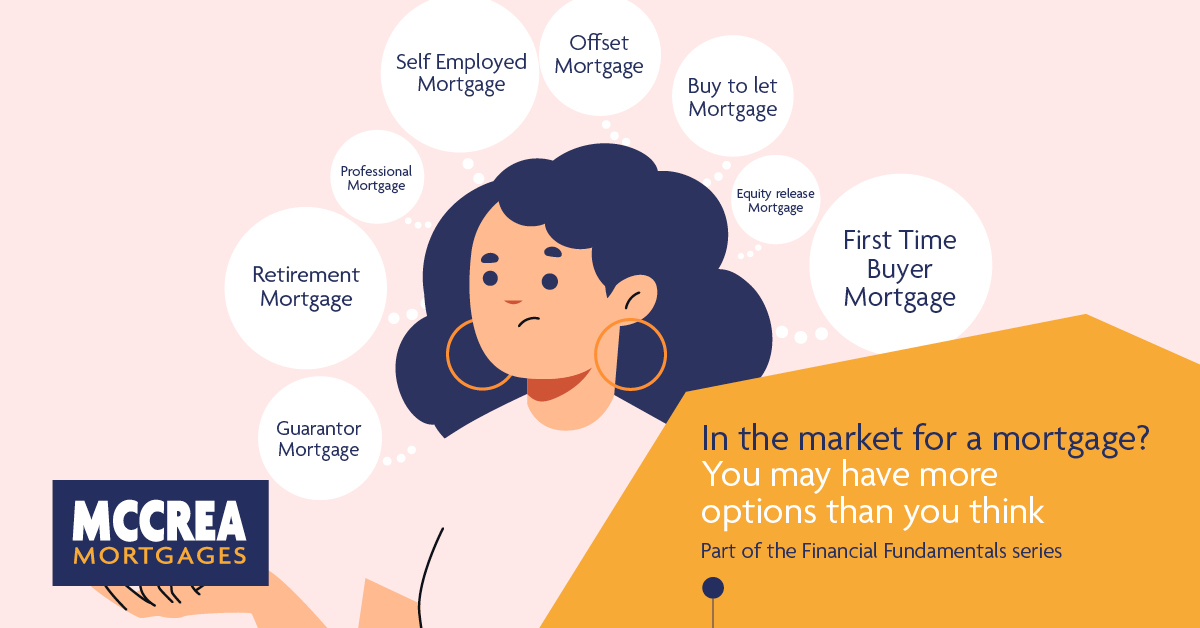Financial Fundamentals: Understanding your Mortgage Options
The McCrea Financial Fundamentals series is your guide to the most important issues affecting your family’s finances. Make informed decisions in these areas and you could secure a more prosperous future. This month we focus on understanding your mortgage options.

A mortgage will usually be the biggest financial commitment we make in our lives, but many of us enter into them without fully exploring all the options open to us. While much of the information available focuses on mortgage for first time buyers and mortgage for the self-employed, there are a wide variety of mortgage products to suit a range of circumstances.
Here are a few types of mortgage which may be a good fit for your situation.
Buy to let mortgage
What is a buy to let mortgage?
A buy to let mortgage is a mortgage which allows you to own a property while renting it out to tenants on a long or short term basis. You might choose to take on a buy to let mortgage as a property investor or as someone who owns a home they do not wish to live in, for example a home received through inheritance or one you leave to move in with a partner.
How do buy to let mortgage work?
As the owner of a buy to let property, you live elsewhere and rely on the rental income to pay the mortgage on the rental property, usually with the intention of generating a profit after the mortgage and other costs are paid. It’s important to note that a buy to let mortgage must still be paid even when you don’t have a tenant, so you must ensure you have a plan in place to make those repayments. Lenders usually want the monthly rental income to be 25-30% higher than your mortgage payment to make sure you will be able to afford consistent repayments.
What are the advantages and disadvantages of a buy to let mortgage?
A buy to let mortgage could help you build an income stream as a private landlord while investing in property long term or retain ownership of a property you don’t wish to use as your primary residence.
Buy to let mortgages tend to require a higher deposit, usually around 25-40%, and also incur higher arrangement fees. Purchases of second homes are subject to higher stamp duty, known as the land and buildings transaction tax in Scotland. Income earned on your second hone will be subject to income tax and you may have to pay capital gains tax if you sell the property in the future.
There are risks associated with buy to let properties. As well as weathering times without tenants, you will be responsible for any repairs or maintenance necessary to keep the property fit for your tenants to live in. Relying on property as a long term investment puts you at risk of being in negative equity if house prices fall.
Offset mortgage
What is an offset mortgage?
An offset mortgage is a mortgage where your lender reduces the amount of interest you pay on your mortgage by the same amount as any savings you hold with that lender.
How does an offset mortgage work?
Offset mortgages work by linking the amount you owe on your mortgage to the amount of money you keep in a bank or building society account with the same lender. If, for example, you had £100,000 outstanding on your mortgage balance, but held savings of £10,000 with the same lender, an offset mortgage would mean you would only be charged interest on a sum of £90,000.
What are the advantages and disadvantages of an offset mortgage?
By calculating your interest on a lower sum, an offset mortgage allows you to pay down your mortgage faster, sometimes saving thousands of pounds and paying off your mortgage years earlier. Your savings don’t need to be unattainably high to benefit from an offset mortgage: a sum of £2,500 could shorten a 25 year £100,000 mortgage by seven months.
Although offset mortgages do allow you to access your savings at any time, withdrawing from your offset savings can increase your monthly mortgage payment. Savings being offset against your mortgage also do not attract interest, although this is often balanced out by the benefit of reducing your overall mortgage liability.
Guarantor mortgage
What is a guarantor mortgage?
Sometimes known as a family assistance mortgage, a guarantor mortgage is one where another person, usually a parent or other family member, gives a legally binding undertaking that they will make payments on your behalf if you become unable to pay your mortgage.
How does a guarantor mortgage work?
The person who commits to making payments on your behalf if the need arises is called your guarantor, as they are providing a guarantee that the lender will be repaid. Your guarantor does not own any share of your property under a guarantor mortgage, but they must provide assurance that they will make payments on your behalf if needed.
What are the advantages and disadvantages of a guarantor mortgage?
A Guarantor mortgage represents a lower risk for the lender, so they are a popular way for borrowers to overcome circumstances which might otherwise prevent them from getting onto the housing ladder, such as having little or no deposit, a low income or a poor credit history.
Like all mortgages, your home is at risk if you do not keep up with your repayments. With a guarantor mortgage, this risk also extends to the person who has committed to making your payments if necessary, which can place their home or savings at risk. As a result, it’s always advisable to be up front about your finances if you’re thinking about participating in a guarantor mortgage, and to take professional advice before proceeding.
Assisted buying mortgage
What is an assisted buying mortgage?
Assisted buying mortgage are a group of mortgage products and government schemes which aim to help homeowners and would-be homeowners who find standard mortgages just beyond their reach. This might include government schemes like Help to Buy, New Supply Shared Equity or 95% government-backed mortgages, or tailored products from lenders like a first time buyer mortgage.
How does an assisted buying mortgage work?
Each assistance scheme and product has its own eligibility criteria, so expert advice is crucial to help identify the best option and ensure you can demonstrate how you satisfy the eligibility criteria. Help to Buy, for example, which is still accepting applications to the Smaller Developer Scheme, requires buyers to complete the purchase of their new build home no more than nine months after submitting their application. There are often criteria governing which homes you can purchase in an assistance scheme, for example Help to Buy is available on new build properties of up to £200,000, while a government-backed 95% mortgage is available on any home up to the value of £600,000, subject to the usual lender criteria. There is also the issue of some assisted buying schemes in Scotland and England running at slightly different times and for different amounts to double-check.
What are the advantages and disadvantages of an assisted buying mortgage?
Each scheme and product has its own advantages and disadvantages, and we can help you find the most beneficial option to get you moving as well as pointing out the pitfalls which might catch out other buyers.
Government-backed 95% mortgages, for example, provide a guarantee to lenders that the government will act as guarantor for your mortgage if you default on your mortgage, however this guarantee expires after a period of seven years. Help to Buy recipients are provided with funding for up to 15% of the purchase price of their home, but are generally prevented from making extensions or improvements to their home while the government retains an equity stake.
With all assisted buying options, it can be an onerous and time consuming task to comb through the small print and satisfy the requirements of the various parties involved, so working with an independent adviser like McCrea Mortgages can significantly lighten the load.
Professional mortgage

What is a professional mortgage?
A professional mortgage is a standard mortgage offered on an exclusive basis to members of certain professions such as doctors, dentists, accountants, solicitors and teachers. Many lenders have their own criteria of professions which they consider eligible, and some will include trainees.
How does a professional mortgage work?
Professional mortgage work in the same way as an ordinary mortgage, but may offer preferential terms. These include features which are now hard to access in the standard mortgage market such as interest only mortgages and deposits of only 15%, 5% or even 0%. While a standard mortgage may offer an average of four times a borrower’s income, a professional mortgage may offer five times the income, and occasionally even more.
What are the advantages and disadvantages of a professional mortgage?
A Professional mortgage are offered to people performing certain roles as lenders consider them lower risk over the lifetime of the mortgage. This can be due to the higher likelihood of stable, often public sector employment, and the expectation of progression along clear career paths with associated rises in income. Professional mortgages recognise that while some people may have spent longer training and qualifying while their peers began to earn, they are more likely to enjoy higher incomes over time. Professional mortgages can also account for uneven or unpredictable income, such as lawyers who operate on a fee basis and professionals who are technically self-employed such as GPs.
Retirement interest only mortgage
What is a retirement interest only mortgage?
A retirement interest only mortgage allows homeowners aged 55 and over to remain in their home while taking out a loan against its value. Borrowers pay a fixed payment each month which covers only the interest which has accrued on the loan, offering a low and predictable monthly payment.
How does a retirement interest only mortgage work?
With a retirement interest only mortgage, borrowers pay a fixed sum each month to repay the interest on the mortgage loan. Homeowners remain in the home for an unlimited time until the last signatory to the mortgage passes away or moves into long term care. At that point, the home is sold and the balance of the mortgage is paid from the proceeds of the sale.
What are the advantages and disadvantages of a retirement interest only mortgage?
The fixed monthly payment offers a reliable way to plan financial arrangements for the duration of your retirement and the payment is generally lower than one for a repayment mortgage. Taking out a retirement interest only mortgage can help homeowners settle previous mortgages as they approach retirement, or move on from a previous interest only mortgage. Unlocking equity in the home with a retirement interest only mortgage allows for discretionary spending and making gifts to loved ones, all while enjoying the ability to stay in the family home.
Because the home will eventually be sold to settle the mortgage, borrowers are unable to pass their home onto family, and any money gifted during retirement or from the sale of the home after settlement of the mortgage could be subject to inheritance tax. Although homeowners are free to move if they wish and can transfer their mortgage to a new property, they may have to repay a portion of the mortgage if their new home is worth less than the original property, which limits the potential to downsize as needs change.
Lifetime mortgage
What is a lifetime mortgage?
Like a retirement interest only mortgage, a lifetime mortgage allows homeowners aged 55 and over to remain in their home while taking out a loan against its value. Unlike a retirement interest only mortgage, however, a lifetime mortgage allows the option of making no monthly repayments. Lifetime mortgages are one of the most popular ways for homeowners to release equity from their home, and allow people who may be asset-rich but cash-poor to access funds to pay for major spending, helping family members or maintaining a comfortable lifestyle in retirement.
How does a lifetime mortgage work?
With a lifetime mortgage, homeowners can choose to receive a one off lump sum, regular smaller lump sums or monthly instalments in return for securing a mortgage loan against their home. It is possible to move home while having a lifetime mortgage, as long as the lender can be satisfied that the new property provides an adequate security for your loan.
Just as with a retirement interest only mortgage, homeowners remain in the home for an unlimited time until the last signatory to the mortgage passes away or moves into long term care. At that point, the home is sold and the balance of the mortgage is paid from the proceeds of the sale.
What are the advantages and disadvantages of a lifetime mortgage?
The option of making no monthly repayments can free up significant disposable income, as can the receipt of a lump sum or regular income from your loan. This can help homeowners enjoy a comfortable retirement, particularly if they have not made comprehensive retirement plans. A lifetime mortgage also allows homeowners to stay in the family home for as long as they choose to, and all lifetime mortgages must offer a ‘no negative equity guarantee’, protecting you and your loved ones from owing money to your lender if the value of your home falls.
Because the home will eventually be sold to settle the mortgage, borrowers are unable to pass their home onto family, and although part of the value of the home can be ring-fenced to provide a legacy to loved ones, this and any gifts made from the proceeds of the loan could be subject to inheritance tax. Opting not to make monthly payments can see interest stacking up on top of your original loan amount, making a lifetime mortgage more expensive than many other methods of borrowing money. Receiving money through lump sums or regular payments can affect your eligibility for means tested benefits, including those you might plan to rely on to fund long-term care, and can impact your liability for Capital Gains Tax, Income Tax and Inheritance Tax.
Which mortgage is right for you?
Whatever your circumstances, it’s likely you have multiple mortgage options available to you. Each type of mortgage has its advantages and disadvantages, and it’s crucial you fully understand the commitment you are making when signing up.
Our mortgage team are fully qualified to help you navigate the mortgage minefield. Not only will they help you secure the best deal at the outset, but they’ll also undertake regular reviews so you can always enjoy the peace of mind of knowing you’ve found the right mortgage for you.
Why not get in touch for a free no-obligation consultation to explore your options with our mortgage team?
